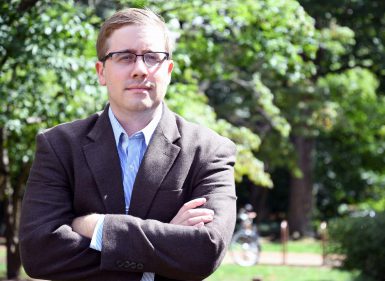Browning argues for new context for public relations ethics history

Public relations is one of the few industries that debates whether it is a real profession.
It is a profession — and has been one for quite some time — argued assistant professor Nick Browning in “The Ethics of Advocacy: A Search for Historical Context in Public Relations’ Theory and Practice,” the first Media School research colloquium of the semester. But Browning finds problems in how academia portrays the industry.
Referencing his latest paper, “Ethics and the Profession: The Evolution of PR Practice from Associate to Accreditation, 1936-1964,” which will be published in American Journalism, Browning argued that public relations and its ethics and influence have been too broadly portrayed. He advocated for a more complex portrayal of the profession and its ethics.
“There are four types of public relations, and they are being taught in a linear progression towards a more ethical practice,” Browning said. “The linear history that gets put forward is off to me.”
Browning described the four models of public relations as they are perceived, in the order they were introduced:
- Press agentry, considered to be flagrantly disregarding accuracy
- Public information, a model in which public relations representatives are journalists-in-residence who disseminate the truth to the public
- Two-way assymetric, the public information model with the addition of an ability for the public to interact with the organization
- Two-way symmetric, which emphasizes an open dialogue between a business and its customers and is the most popular model today
“The symmetric model is the one that is touted as the most effective, but I have issues with this model,” Browning said.
One issue: Dialogue isn’t always helpful.
“There’s a danger of hegemony,” he said. “If I am listening to you with the full intention of ignoring you, isn’t that not ethical?”
Browning analyzed several decades’ worth of texts discussing public relations written by experts in mainstream publications to study how the perception of public relations and its role in society has changed throughout history.
He found the four models throughout history in all kinds of settings. World War I was a breeding ground for the first public relations experts, he found, and led to a time where businesses were self-serving. That all changed in the stock market crash of 1929, when big business was blamed for the economic decline, and these industries were forced to look inward. Finally, into the 1950s, corporations began using corporate conscience as a means of connecting with their customers and improving their bottom line.
Browning said he expects to face some opposition to his push toward re-evaluating perceptions of the industry’s history and progress. But he stressed the importance of a new approach, in order to better understand the influence of public relations.
More:

